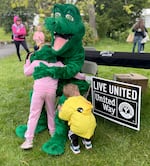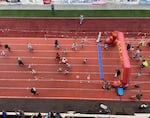
Kids take off from the starting line at the annual Awesome 3000 youth fun run in Salem, Ore., on April 27, 2024. More than 2,000 kids participated this year.
Natalie Pate / OPB
On a misty, gray morning at Bush’s Pasture Park in south Salem this spring, hundreds of kids ran around McCulloch Stadium in controlled chaos.
It was loud — the giggles, the announcer, the kids’ neon blue T-shirts. It was windy. The air smelled like rain and wet turf.
The kids were separated by grade and gender as they played games to warm up. Some ran around, squealing. Some were dressed up, with fancy tutus or spiky mohawk haircuts to mark the occasion. A few of the younger ones — overcome by the moment — cried. Some were nervous, but they all said they were excited.
Why?
“Cuz we’re about to do the race,” one kindergartener answered.
“This is my first time,” he admitted, adding, “but I’m very fast.”
There are hundreds more people in the stands. Parents, siblings, friends and family of all kinds watching and waiting to cheer for every single kid — preschool through high school — who crosses the finish line.
The energy is electric even before anyone’s running.
“Five, four, three, two, one,” the crowd counts down before every race. Then, with the “boom” of the gunshot, they’re off.

Elementary students walk and jog through Bush's Pasture Park for the annual Awesome 3000 youth fun run in Salem, Ore., on April 27, 2024.
Natalie Pate / OPB
The Awesome 3000 fun run started in the early 1980s, as the story goes, when a small group of parents sat around a kitchen table and brainstormed ways to raise money for local teachers.
Sponsors pay for the event itself. The runners’ registration fees pay for teachers’ grants in Salem-Keizer Public Schools, Oregon’s second-largest school district.
Over the decades, Awesome 3000 has grown into a beloved rite of passage for Salem-area kids. This year, more than 2,000 took part. In its heyday, before the pandemic, add another thousand to that.
“It’s not about being the first one done. It’s all about doing your best,” said Jeremiah Rasca, a P.E. teacher and volunteer at the event. People may recognize him as the man in the cape.
“If you do your best, if you finish the race, you win,” he told OPB. “And that is something that any of my students, any of the students who get a chance to run can do.”
In his superhero costume, Rasca helps the students move from their central gathering spots on the field — where they play games and warm up — to the starting line.
The runs are staggered, one after the other all morning long.
The kids run their routes. Younger kids and runners with disabilities, who participate in the partner Unified run, typically run a shorter distance on the track. Older kids jog through the surrounding park.
At the end of the race, volunteers like Rasca help shepherd the kids from the finish line to the outer part of the stadium. There, they collect their goodies — medals, water bottles, free books — and meet up with their families.
“It’s just a great sense of accomplishment for students [who] may be worried about being the absolute best at something, they can still be successful,” Rasca said.
Jodi Blackman, coordinator of the event, agreed.
“Those kids hit that stadium and run past the stands, and everyone’s cheering and, I mean, how many moments do you get like that in your life?”
Blackman is the chief program officer for the United Way of the Mid-Willamette Valley. The event was paused at the start of COVID-19. Around the same time, the original organization that ran it — the Salem-Keizer Education Foundation — dissolved. The United Way took over and brought back the run for the first time again last year.
Few elements have changed under the new leadership. Students, for example, still compete before the event for who gets to design this year’s logo. At the event itself, there are still booths lining the entrance of the stadium, a spot to grab breakfast, and a place to take photos with the Awesome 3000 mascot, Geo the Alligator.

Kids hug the Awesome 3000 mascot, Geo the Alligator, at the annual fun run on April 27, 2024, in Salem, Ore.
Natalie Pate / OPB
Some changes have been arguably for the better. For instance, they’ve made it easier for parents of children with disabilities to watch their kids take part.
And the core purpose of the event is the same — to raise money for local teachers.
“We were kind of thinking, ‘What are those things that teachers spend their own money on, that we could help and spend this money on?’” Blackman explained.
Last year, United Way awarded more than $40,000 for nearly 30 different grants throughout the district. Recipients used their shares of the money on things like classroom equipment, supplies or field trips. This, during a time when districts across the region, including Salem-Keizer, are facing major budget cuts.
But at the end of the day, it isn’t just about the money.
Over the decades, Awesome 3000 has become, as Blackman put it, woven into the fabric of the community. Ask almost anyone from around Salem about it, and they’ll have a connection.
“It’s just like, got this feel to it. You know, there’s this buzz and this feel, and everybody is happy,” Blackman said. “And it’s just, I don’t know, there’s something about it.”

Kids run across the finish line at the Awesome 3000 youth fun run on April 27, 2024, in Salem, Ore.
Natalie Pate / OPB
